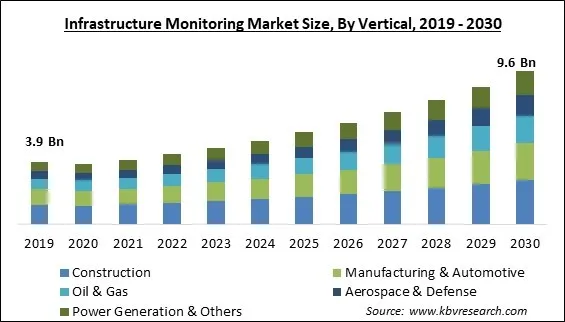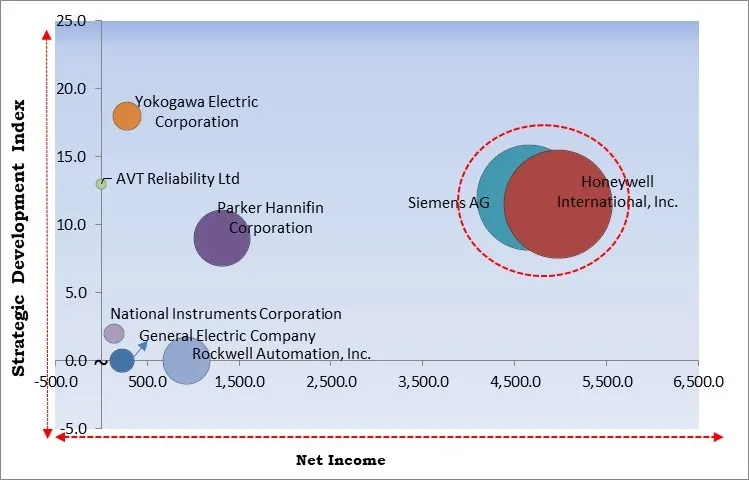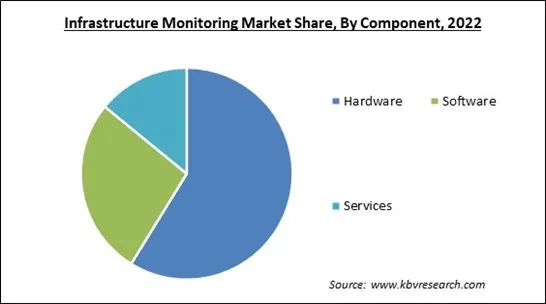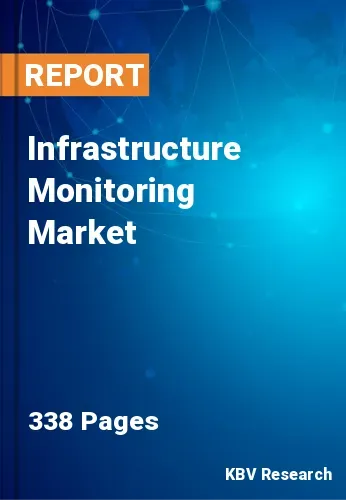The Global Infrastructure Monitoring Market size is expected to reach $9.6 billion by 2030, rising at a market growth of 10.4% CAGR during the forecast period.
The requirement of Damage Detection is growing rapidly as it plays a key role in Infrastructure monitoring. Hence, the damage detection segment is expected to acquire approximately 1/5th share of the market by 2030. The market is seeing a sizable opportunity for damage detection applications due to the increased focus on establishing cutting-edge sensor technologies and integrating machine learning and artificial intelligence. These sensors will have greater sensitivity, better precision, and more durability, enabling more accurate & dependable damage detection. For instance, adding intelligent components to sensors, like carbon nanotubes or self-healing polymers, can improve their functionality and enable self-monitoring.

The major strategies followed by the market participants are Partnerships as the key developmental strategy to keep pace with the changing demands of end users. In May, 2023, Parker Hannifin Corporation came into partnership with the U.S. Army to provide upgradation solutions for UH-60 Blackhawk's flight control actuation. In July, 2021, AVT Reliability Ltd. partnered with Teledyne FLIR to provide solutions for thermal imaging and enable AVT to provide its customers with solutions for asset condition monitoring through thermal imaging systems.
Based on the Analysis presented in the KBV Cardinal matrix; Siemens AG and Honeywell International, Inc. are the forerunners in the Market. In April, 2023, Siemens AG signed an agreement with Leonardo to develop solutions for Industrial infrastructure security and enable their Italian customers with solutions for secure digital transformation. Companies such as Parker Hannifin Corporation, Yokogawa Electric Corporation, Rockwell Automation, Inc. are some of the key innovators in the Market.

The expanding number of smart city projects demand automated monitoring and inspection systems for their infrastructure or buildings due to the high labor cost in developing countries. Modern technology, such as IoT and sensor systems, is incorporated into infrastructure monitoring systems to accomplish this information. Modern technology and infrastructure monitoring work together to enable continuous collection and analysis of building monitoring data for preventative maintenance. This market is expected to develop as improved technologies gain prominence.
Due to the rising need for techniques that increase energy efficiency, sustainability, and cost-effectiveness, the energy segment is predicted to gain substantial popularity in the market. Additionally, the expansion of infrastructure monitoring in the energy industry has a bright future due to the increasing significance of timely and predictive maintenance for energy sector assets. In addition, both onshore and offshore systems in this business can greatly benefit from the remote maintenance advantages of structural health monitoring systems.
The expanding number of devices and networks that need to be monitored is the most major problem with infrastructure monitoring. The infrastructure of the organization expands along with it. It can be difficult to keep track of the many hardware and software that make up an organization's IT ecosystem. However, monitoring each of them at the top make’s things even more difficult. The market would drop due to the difficulty in maintaining comprehensive monitoring of all the information due to the excessive volume of data.
On the basis of vertical, the market is fragmented into oil & gas, manufacturing & automotive, aerospace & defense, construction, and power generation. The manufacturing & automotive segment covered a considerable revenue share in the market in 2022. Manufacturers know the value of integrating monitoring systems to optimize production infrastructure as the emphasis on high operational efficiency, asset management, and safety rises. Manufacturers can proactively identify and resolve problems with equipment performance, pipeline integrity, and the general condition of the infrastructure by implementing the systems.
On the basis of component, the market is segmented into hardware, software, and services. The services segment acquired a substantial revenue share in the market in 2022. In the process of monitoring infrastructure, the services component is crucial. The services cover a wide range of tasks that aid in the established usage and maintenance of monitoring systems. Service specialists guarantee the system is configured, calibrated, and correctly integrated for accurate data collection. The operators can benefit from infrastructure monitoring through these services for improved asset management, safety, and efficiency.

By application, the market is categorized into corrosion monitoring, crack detection, damage detection, vibration monitoring, thermal monitoring, multimodal sensing, strain monitoring, and others. In 2022, the vibration monitoring segment registered the highest revenue share in the market. Vibration monitoring enables the evaluation of structural dynamics, the identification of potential stability problems, and the assessment of the effect of vibrations on the overall infrastructure's performance. To assure the structural health & integrity of the infrastructure, it is widely used in various industries, including construction and other industrial facilities.
Based on technology, the market is classified into wired, and wireless. In 2022, the wired segment garnered a significant revenue share in the market. Since they use actual cables and wired connections to transport data between different monitoring system components, wired systems play a significant role in the market. Wired systems offer a reliable and steady method of data transmission and communication. It is most suitable for dependable and ongoing monitoring applications, such as natural gas pipelines and vital equipment.
| Report Attribute | Details |
|---|---|
| Market size value in 2022 | USD 4.4 Billion |
| Market size forecast in 2030 | USD 9.6 Billion |
| Base Year | 2022 |
| Historical Period | 2019 to 2021 |
| Forecast Period | 2023 to 2030 |
| Revenue Growth Rate | CAGR of 10.4% from 2023 to 2030 |
| Number of Pages | 341 |
| Number of Table | 504 |
| Report coverage | Market Trends, Revenue Estimation and Forecast, Segmentation Analysis, Regional and Country Breakdown, Competitive Landscape, Companies Strategic Developments, Company Profiling |
| Segments covered | Component, Technology, Application, Vertical, Region |
| Country scope | US, Canada, Mexico, Germany, UK, France, Russia, Spain, Italy, China, Japan, India, South Korea, Singapore, Malaysia, Brazil, Argentina, UAE, Saudi Arabia, South Africa, Nigeria |
| Growth Drivers |
|
| Restraints |
|
Region wise, the market is analyzed across North America, Europe, Asia Pacific, and LAMEA. In 2022, the North America region led the market by generating the largest revenue share. In North America, manufacturers from various industries have realized how important it is to maintain the infrastructure's integrity and effective operation. Solutions that enhance safety, improve maintenance procedures, and boost overall operational performance have become an increasingly greater need. Due to a greater cluster of service providers offering monitoring tools and solutions for small & large corporate businesses, North America is expected to contribute significant advances across the globe.
Free Valuable Insights: Global Infrastructure Monitoring Market size to reach USD 9.6 Billion by 2030
The market research report covers the analysis of key stake holders of the market. Key companies profiled in the report include Parker Hannifin Corporation, Siemens AG, General Electric Company, Honeywell International, Inc., Rockwell Automation, Inc., Yokogawa Electric Corporation, National Instruments Corporation, Acellent Technologies, Inc., Campbell Scientific, Inc., AVT Reliability Ltd (A.E.S. Engineering Limited).
By Vertical
By Application
By Component
By Technology
By Geography


The Market size is projected to reach USD 9.6 billion by 2030.
Growing Application in Energy Sector are driving the Market in coming years, however, Monitoring The Vast Amounts of Data is Challenging restraints the growth of the Market.
Parker Hannifin Corporation, Siemens AG, General Electric Company, Honeywell International, Inc., Rockwell Automation, Inc., Yokogawa Electric Corporation, National Instruments Corporation, Acellent Technologies, Inc., Campbell Scientific, Inc., AVT Reliability Ltd (A.E.S. Engineering Limited).
The Construction segment acquired maximum revenue share in the Market by Vertical in 2022; thereby, achieving a market value of $2.8 billion by 2030.
The Hardware segment is leading the Market by Component in 2022; thereby, achieving a market value of $5.4 billion by 2030.
The North America region dominated the Market by Region in 2022, and would continue to be a dominant market till 2030; thereby, achieving a market value of $3.3 billion by 2030.
Our team of dedicated experts can provide you with attractive expansion opportunities for your business.

